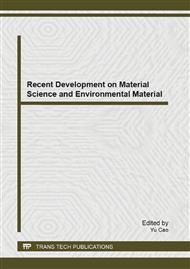p.505
p.509
p.517
p.522
p.526
p.531
p.537
p.546
p.550
Platinum Nanoparticles Supported on Noncovalent Functionalized Graphene as Cathode Catalysts for Aluminum-Air Batteries
Abstract:
Platinum nanoparticles deposited on noncovalent functionalized graphene modified by 1, 10-Phenanthroline were prepared by ethylene glycol reduction process under the assistance of the microwave. The structure, morphology, composition and surface properties of the as-prepared catalysts Pt/graphene are characterized by X-ray powder diffraction (XRD) and transmission electron microscopy (TEM). The results showed that platinum particles were uniformly dispersed on the surface of 1,10-Phenanthroline noncovalent modified graphene, and the particle size was about 1nm. Cyclic voltammetry(CV), linear sweep voltammetry(LSV) and Tafel curves were used to test the oxygen reduction electrode. Through electro-chemical testing, we found that the graphene based electrocatalysts significantly increased the oxygen reduction reaction(ORR) of aluminum-air batteries. This result illustrated that Pt nanoparticles deposited on noncovalent functionalized graphene could be used as an efficient catalyst material for aluminum-air batteries with the feature of much increased catalytic activity.
Info:
Periodical:
Pages:
526-530
Citation:
Online since:
September 2013
Authors:
Keywords:
Price:
Сopyright:
© 2013 Trans Tech Publications Ltd. All Rights Reserved
Share:
Citation:



